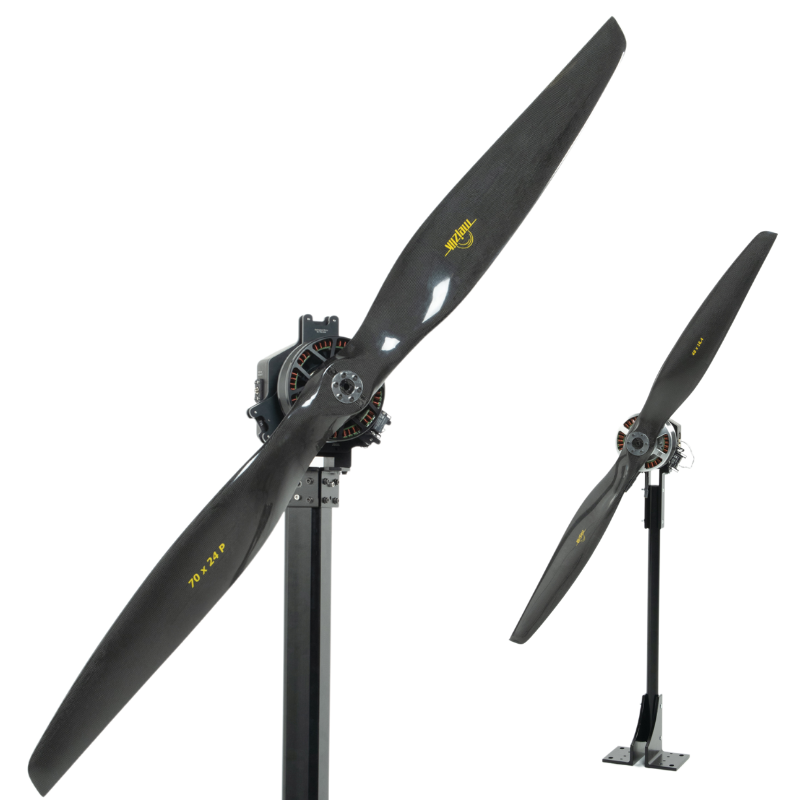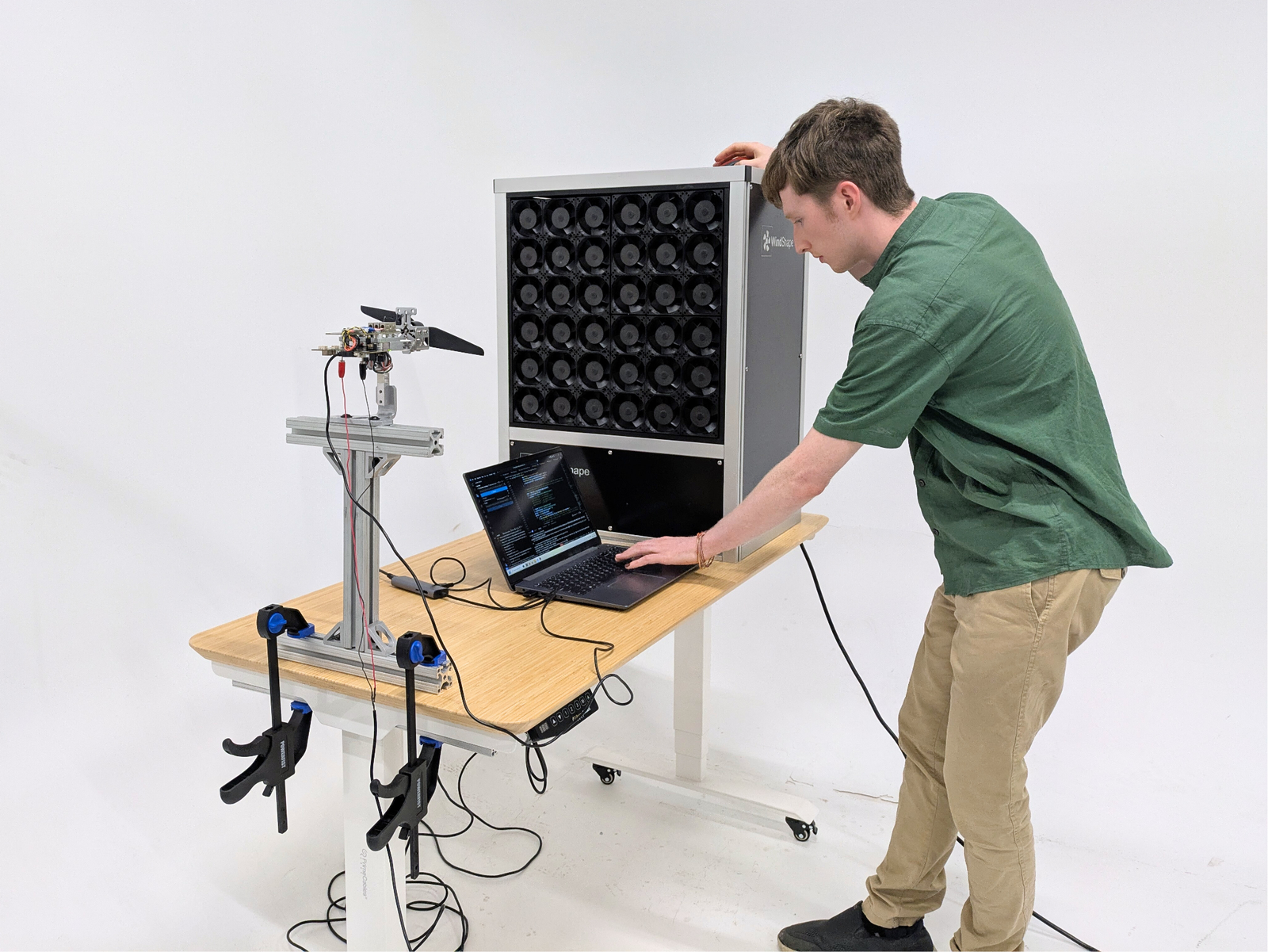Introduction
A question we often get goes something like this: “We’re planning on running CFD simulations, do we still need to test our motors and propellers experimentally?”
We may be biased, but our answer is always yes, and for good reason.
We perform plenty of CFD simulations ourselves, but we acknowledge that they are not a way to get definitive answers about a propulsion system, they simply enable us to make predictions about how a motor or propeller might perform.
Simulations are especially useful to predict the effects of altering specific variables in an already well characterized system.
How big is the difference between simulation and reality? It depends on a lot of factors,like the choice of turbulence models, mesh type and sizing, boundary conditions and discretization methods used.
In this report, we quantified the difference between simulation and reality for a 60” UAV propeller, results below.

Summary of the Report
This report summarizes tests and simulations we completed to determine the relationship between numerical simulation results and experimental data for a 60" UAV propeller.
The Ansys Fluent software was used to generate a CFD model of our 60” propeller, which was then experimentally tested with the Flight Stand 150 thrust stand.
What we discovered was that during tests from 1000 - 2000 RPM, the CFD simulation underpredicted thrust by 69%.
Simulations and experimental tests were run in parallel over the course of several weeks. The Ansys simulation was designed to mimic the experimental lab space, including the proximity of walls, obstacles and the overall size of the room. The thrust stand and propulsion system were also modeled to the exact dimensions of their live counterparts. Each Ansys simulation took an average of 10 days to complete using a computer with a latest generation GPU. Occasionally, the simulation would fail to converge and the parameters would have to be adjusted before restarting the simulation. Overall, the dozen simulations we completed took about 20 weeks to run. Preceding the simulations, our team completed 16 hours of training with a consultant. In parallel, we ran experimental tests using the Flight Stand 150 thrust stand. We used a 60 kW power supply to power the stand, mounted with a TA150 motor and 60” propeller. Figure 2: 60” propeller modelled in Ansys (left) and tested on the Flight Stand 150 (right) Thrust Stand:Flight Stand 150 (150 kgf / 150 Nm) Motor: TA150 Propeller: 60” diameter ESC: Pulse P40 Power Source: 60 kW power supply from MCB Electronics Software: Flight Stand software Test area: Distance from Flight Stand to back wall - 3 m Distance from rotating domain to top wall - 3 m Distance from rotating domain to side walls - 2.74 m Software Ansys Fluent - Version R1 (21.1) Geometry of Static Domain X - 7.06 m (width) Y - 5.1 m (height) Z - 15.3 m (length - wall downstream of propeller to wall upstream of propeller) Mesh Discretization Scheme Turbulence Model Figure 3: Thrust vs. RPM curve of Experimental and CFD Data A Python script was developed to find a relationship between the experimental data and CFD data using least squares polynomial regression. This relationship was developed usingONLY the experimental data points available up to 1900 RPM. The objective of this regression was to generate a function as follows: The steps undertaken to achieve this are as follows: The generated equations and plots for the concerned data range are presented below: Figure 4: Least squares curve fit of experimental thrust data Figure 5: Least squares curve fit of CFD thrust data Figure 6: Least squares regression of experimental and CFD thrust data As seen in Figure 6, there is a linear relationship between the experimental and CFD data. The experimental thrust value is approximately twice that of the thrust value predicted by CFD. This section explains how to estimate the pressure forces from a propeller on the Flight Stand structure from experimental data at a constant RPM. The process is followed for a 60 inch propeller with 2 blades on the Flight Stand 150 and the results are presented below. Premise: Hypothetically, if a perfectly balanced propeller attached to the force measurement unit (FMU) is spinning freely in the absence of a stand structure, ‘Mx’ & ‘My’ measurements would be zero. However, in the presence of a stand, every time a propeller blade passes by the structure, a high pressure zone is created between the propeller blade and stand. This causes the FMU to register an Mx moment. This moment can be used to estimate the maximum force on the stand due to fluid-structure interaction. In reality, propellers are not perfectly balanced and might have one blade generating more thrust than the other (for a two blade propeller). This would result in an oscillatory ‘My’ measurement on the FMU, the maximum being when both the propeller blades are 90 degrees away from the stand (horizontal position of the propeller). In the absence of a stand, this moment would appear as an ‘Mx’ measurement when the propeller is vertically aligned and as an ‘My’ measurement when the propeller is horizontally aligned. The magnitude of this moment due to an imbalanced propeller remains constant throughout a cycle but continuously changes in direction. When the propeller is vertically aligned with one blade being in front of the stand, the sum or difference, (depending on how the propeller is imbalanced) between the maximum ‘Mx’ measurement and the maximum ‘My’ measurement during a full cycle, is the resultant moment generated purely due to fluid-structure interaction between the propeller and the stand. This is the method used to estimate stand force due to fluid-structure interaction. The force on the Flight Stand 150 was estimated using this method with a 60 inch propeller mounted on it and spinning at 1932 RPM. The forces and moments about the three axes were first calculated using load cell voltage raw values. After obtaining these values, ‘Mx’ & ‘My’ were plotted on top of each other. Figure 7: Mx and My for propeller on stand over time In the figure above, the distance between two green dot-dash lines ‘-.’ indicates one full revolution of the propeller. Our results demonstrated that a CFD model was able to predict propeller thrust performance with a 69% difference from experimentally measured data. An ideal approach to propulsion testing uses both CFD simulations and experimental tests to characterize powertrain performance. Once the experimental data is collected,a relationship can be developed between the CFD data and experimental data, which can be used to make predictions of thrust and torque values for higher RPM's up to a certain value. Once a relationship has been established, it can be used to make predictions about the performance of the system with slight modifications, like using a propeller with a different pitch, or operating the system at higher RPM. In general, CFD is useful for making predictions, but it is always a good idea to validate the results experimentally. If you’d like to test your motors and propellers experimentally, we recommend one of the thrust stands below:Procedure

Specifications:
Experimental Test:
CFD Model:
Results





Stand Force Calculation From Experimental Data:

Conclusion


 Back to Blog
Back to Blog


Ziad Boutanios
October 16, 2024
Interesting hybrid approach, and always good to have both numerical and experimental simulations. However, I do believe it is possible to squeeze better accuracy out of your CFD modelling at a reasonable cost.
The following points can be readily improved:
- K-Omega-SST is an isotropic model, with significant limitations considering the highly anisotropic turbulence field generated by a propeller. I would recommend DES or LES instead. Properly set up, these models should get you accuracy better than 10% vs. experiment.
- Steady state flow is a purely theoretical concept, meant strictly for general assessment. For rotating propellers, one should really run transient simulations. They take more time, but they are more stable numerically, and more accurate.
- The boundary layer needs to be resolved, and the mesh built in that perspective.
- Fluent is not the only viable game in town. There are highly reliable open-source CFD codes out there that will allow you to shift funds from licensing to computing hardware that can be amortized over 4 to 6 years.
We can discuss if you’re interested.